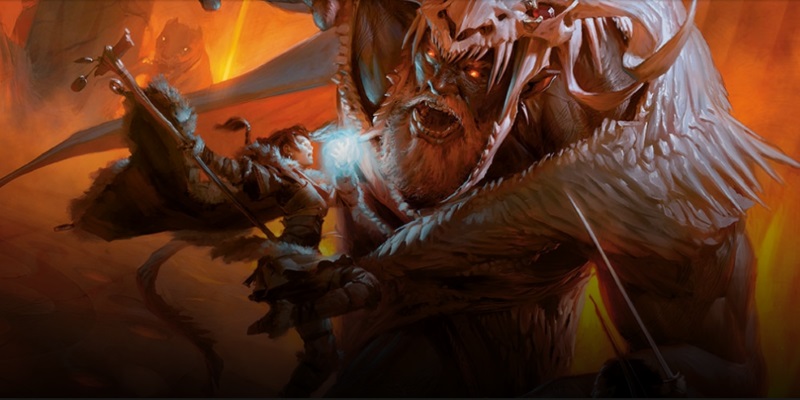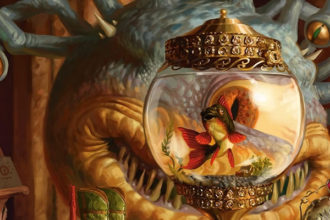Unearthed Arcana: Barbarian Primal Paths Breakdown

There’s big news today from WotC: we’ll be getting UA articles more than once a month for awhile. That’s particularly exciting for commentators like me, but it’s good news for everyone who enjoys 5e content. Even though some UA articles are less polished than others, they’re always good insights into the future of 5e and what the designers see going on in the game.
Since the release of the Player’s Handbook, barbarians have been substantially under-supported in official releases. The Totem Warrior has strong internal variety – it could potentially be twenty-seven different subclasses! – but it still reads like one subclass on the page, while the Berserker is a classic archetype but hard to use well and quite narrow in its function.
Hither came this article, Unearthed Arcanian: Ancestral Guardians, Storm Heralds, Zealots, greataxe in hand, a tank, a damage aura one, a religious one, with unusual features and gigantic mirth, to tread the jeweled thrones of the PH subclasses under their sandaled feet.
Path of the Ancestral Guardian
Lo there do I see my father; Lo there do I see my mother and my sisters and my brothers; Lo there do I see the line of my people, back to the beginning. Lo, they do call me, they bid me take my place among them, in the halls of Valhalla, where the brave may live forever.
The theme of this iconic enough that it sort of feels like the one that was missing from the Player’s Handbook. You draw strength from your tribal ancestors? It’s a pretty perfect pairing with the Totem Warrior. Of course, I’m reminded that D&D has always had precise taxonomy for everything except spirits: a genius loci and a non-malevolent ghost are both just “spirit.” This bugs me more than it should.
Anyway, what does the Path of the Ancestral Guardian do?
- Ancestral Protectors is a 4e Marking mechanic, pretty straight up.
- It sets me up to assume that the rest of this subclass is about tanking. It’s also a pretty convincing skin on that mechanic. It costs a bonus action each turn, but the barbarian isn’t nearly as taxed for bonus actions as other classes. It does mean you can’t use this on the round that you initiate your rage, and that seems a bit of a problem (with an easy one-line fix).
- The Bear Totem’s Totemic Attunement feature is the closest cousin to this. Naturally, as a 14th level feature, it’s a lot more powerful than Ancestral Protectors.
- Ancestral Shield suggests that this subclass’s damage resistance while raging comes specifically from the ancestors, not from being as tough as other barbarians, because it makes that resistance temporarily transferrable to one target within 30 feet.
- This costs your reaction, but it’s roughly on the order of giving someone else Uncanny Dodge for a moment. That’s enormous. Oh, and it stacks with Uncanny Dodge.
- It also gives you incentive, for the first time I specifically recall, to go out of your way to gain damage resistance from two different sources. That way you can protect a friend (with this feature) while still having protection (from whatever other thing you acquired). Interesting, that.
- Consult the Spirits grants advantage on three Int or Wis checks per long rest.
- It is a mostly non-combat information-gathering feature, and that’s a good thing to see. The theme of this subclass suggests to me that it should be a serious combatant, but should have a variety of non-combat functions as well.
- Of course, it’s still good for Wisdom (Perception).
- Vengeful Ancestors is a damage-dealing reaction. There aren’t that many of those out there, and this one doesn’t even take an attack roll. If you or an ally within 30 feet suffers melee damage while you’re raging, wham, 2d8 force damage.
- I’m a little concerned about the competition for reactions here. Tactical decisions are good; the question is whether this one is satisfying. I don’t hate it – it’s just what I would look at closely in the course of testing.
Overall, I like what I see here. I might prefer something slightly less flashy for ancestor spirits – having them whisper to the character rather than manifest – but it’s not a dealbreaker at all. This is a more active tanking style than the Bear Totem’s “half damage from frickin’ everything while raging” style, and that gets high marks from me; on the other hand, it’s going to have a hard time in a head-to-head power matchup for the same reason. I would say to goose the power on this subclass slightly, but it’s on the right track.
Path of the Storm Herald
Even as the guy who published a storm-themed subclass for rangers, I don’t love having a storm-themed subclass for a ton of separate classes. It makes me miss the Specialties of the D&D Next public playtest – a chain of thematic features that could apply to any class, and could hugely recolor the character’s tone. Does this one have something new to say?
You know what, it does! It’s not a straight-up lightning & thunder theme. Instead – much like the Circle of the Land druid – it has three separate terrains, each of which has its own style of storm: desert, sea, and tundra. I love how much more breadth this gives the subclass to draw in player concepts. How about the mechanics, though?
- Storm of Fury gives you a 10-foot damage aura while raging. For desert and tundra storm heralds, this is automatic damage to enemies ending their turns in that aura. It’s not much more than a splash of damage – it peaks at 7 damage per round. On the other hand, you might add up a lot of separate targets damaged over the course of a fight. Sea heralds, on the other hand, force one creature to make a saving throw, taking a greater amount of lightning damage on a failed save, and half on a success.
- My main concern here is bookkeeping, I think – small amounts of damage can add up to a lot of extra calculation for the DM. There are other damage aura effects in the game, of course – my beloved spirit guardians springs to mind – but this is an effect with an expected uptime of 75% or more of all encounters. Of course, its usefulness all depends on the kinds of encounters the DM runs.
- Storm Soul grants resistance to your terrain’s flavor of damage and an exploration-related feature – ignoring extreme heat, extreme cold, or extreme drowning. This is fine.
- Shield of the Storm ties your Storm Soul to your damage aura, sharing it as an effect to your allies. Exuding the ability to breathe underwater as long as they stay close to you is thematically weird – it makes me wish the Storm Soul feature for Sea did something different, but… eh, whatever. It doesn’t come up that much in most campaigns.
- Raging Storm beefs up your damage aura further, by making it grant you stickiness. (Stickiness: area control on the battlefield, making it harder for enemies to get past you to attack your back ranks.) The three terrains are just different implementations of slowing or stopping enemies in your aura – temporarily reducing speed to 0, knocking targets down, creating difficult terrain.
- The Sea feature here compares closely to the Wolf Totemic Attunement. Where Wolf costs a bonus action but automatically works on a Larger or smaller creature, this works on any size of creature, can work on multiple targets in a round, and grants a saving throw. It’s fine, I guess.
The Path of the Storm Herald requires constant attention to the 10-foot radius around you. It’s a substantial shift in gameplay, in exchange for what could add up to a pretty serious damage output boost over the long haul. I like what it says on theme – as a DM, I am just not crazy about having large numbers of incidences of small amounts of damage.
Path of the Zealot
This is one of the rare cases that I take issue with the specific flavor text describing a subclass. For reasons beyond my understanding, all three core paladin Oaths can be good, bad, or other, but the Zealot gets “In general, the gods who inspire zealots are deities of combat, destruction, and violence. Not all are evil, but few are good”? That’s a pretty harsh line if you’re borrowing a name from Jewish rebels against Roman rule. Nothing in the mechanics suggests that Zealot barbarians are any worse in their methods and goals than any other PC.
- Divine Fury is another damage aura, this one only a 5-foot radius, but dealing a bunch more damage. That damage is either radiant or necrotic, depending on what you choose when you gain the feature.
- Edit: As many others have noted, Divine Fury targets creatures, not enemies, and is thus dangerous to the barbarian’s allies. I assume this will get changed in a later draft, because the rest of the theme doesn’t really push the idea of the Zealot being a team-killer. A jerk, sure; a passive griefer, maybe not.
- Warrior of the Gods makes you cheap to resurrect, costing only a spell slot – no expensive materials.
- On one hand, this lets you treat death even more like a revolving door than other characters. (And it only does anything if you, you know, die.)
- On the other hand, it’s a way for your god to show favor for you that we haven’t seen elsewhere, so that’s neat.
- Zealous Focus is the big surprise of this subclass, though. While raging, you can end your rage and cut off all raging until your next short or long rest to gain a use of Legendary Resistance (in essence). It requires your reaction, as well.
- Any enemy spellcaster that wants to take you down had better toss out a few “bait” effects, and save the serious killing or controlling spells for once you’ve calmed down.
- Zealous Presence, much like Shield of the Storm and Ancestral Shield, lets you provide some support to other party members. In this case, it’s a special battle cry, and certainly could shift the balance of a fight suddenly.
- I’m fascinated to see that all three Paths have one leader-like feature, considering that the two PH paths don’t. I like seeing every character gain a few options that are all about contributing to the team.
- Rage Beyond Death is a surprisingly good handling of the ubiquitous theme of barbarians who continue fighting even when they should have long ago died. On the other hand, I think we now need clarification about what happens when you receive a cure wounds effect while you have three failed death saves, but you are still alive and nominally a legal target for the spell.
Other than my initial objections to the flavor text, I think the Path of the Zealot is a pretty worthy addition to the barbarian oeuvre. It could just as easily be reflavored to be a sword saint or dervish. I really wish the Zealot were appreciably more friendly to a two-weapon-fighting barbarian, but as it is, it doesn’t particularly get in the way.
Conclusion
Yeah, I like what they’re doing here. They’re patching significant gaps in the Player’s Handbook content, and they’re drawing in a good variety of themes. The repeated use of damage auras is not my favorite thing, but there’s no immunity-based design going on, so that’s a welcome shift. The refocus on cooperative interaction in the midst of combat is one of the best parts of 4e, and it’s great to see it work its way back in here.
It sounds like I might be writing a lot more of these breakdowns for some time to come. We’ll see how it goes!



